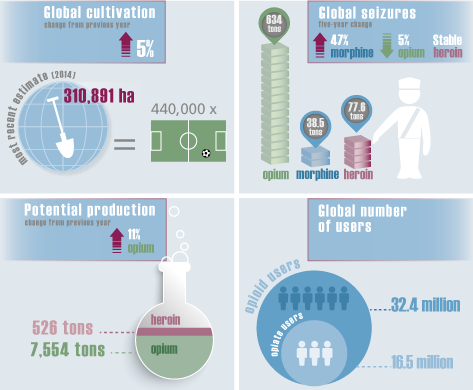

According to the limited information available, global prevalence of the use of opioids (0.7 per cent of the world's adult population, or 32.4 million users) and the use of opiates (0.4 per cent, or 16.5 million users worldwide) has remained stable, whereas global opium poppy cultivation in 2014 reached the highest level since the late 1930s. This was mainly attributable to the fact that opium poppy cultivation reached historically high levels in the main country in which opium poppy is cultivated, Afghanistan, where potential production of opium also continued to increase. Global opium production reached 7,554 tons in 2014, also the second highest level since the late 1930s, though global seizures of opium, heroin and illicit morphine decreased by 6.4 per cent from 2012 to 2013.
The increase in estimated opium and heroin production has not yet been reflected in an increase in heroin supply in most regions. The destination of the additional quantities of heroin is unclear, but there are signs of increases in the availability of heroin and in heroin-related indicators such as mortality and medical emergencies in some countries.
The prevalence of opioid use remains high in North America (3.8 per cent) in relation to the global average. In the United States of America, there are indications of a partial shift in the use of opioids towards heroin use, attributable in part to changes in the formulation of OxyContin, one of the main prescription opioids that are misused, as well as an increase in the availability of heroin and a decrease in its price in some parts of the country. With the number of heroin-related deaths increasing considerably (from 5,925 in 2012 to 8,257 in 2013), reaching the highest level in a decade, the number of drug-related deaths continues to rise in the United States.
There are signs of change in the supply of heroin in different regions. In North America, although 90 per cent of the heroin in Canada originates in Afghanistan, the United States continues to be supplied by heroin manufactured in Central and South America. However, analysis of seizures indicates that while Afghan heroin currently accounts for relatively little of the heroin seized in the United States, this may be changing. In Oceania, there have been fluctuations in the Australian market between the supply of Afghan heroin and heroin originating in the Lao People's Democratic Republic or Myanmar, but it seems that in 2013 the latter was predominant. This underlines the fact that the reach of organized criminal networks continues to be global and that organized criminal groups are becoming increasingly sophisticated and versatile.
In Europe, the heroin market is also marked by variations, albeit at the subregional level. There are indications of a stable or downward trend in the use of heroin in Western and Central Europe, while heroin seizures have recently increased in Eastern and South-Eastern Europe, where the absence of new data prevents the assessment of recent trends in the prevalence of drug use.
In the absence of any recent reliable data on the extent of the use of opioids in most parts of Asia, it is difficult to determine a trend, but the use of opioids is generally considered to be stable. Asia remains the world's largest market for opiates, accounting for an estimated two thirds of all users of opiates, and the total number of registered heroin users in China is increasing. Data on Africa remain limited, but it is likely that the increasing importance of the region as a transit area for Afghan heroin bound for markets in other regions has had an impact on the use of opiates in Africa.